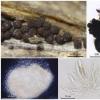
09-12-2025 12:06
 Andgelo Mombert
Andgelo Mombert
Bonjour,Je recherche l'article concernant Hypobryo

07-12-2025 16:07
Arnold BüschlenHallo, ich habe in einer Moos-Aufsammlung (epiphy

08-12-2025 21:04
Mark Stevens"Hello everyone,I'm relatively new to microscopy (

08-12-2025 18:59
 Lothar Krieglsteiner
Lothar Krieglsteiner
.. found by a seminar-participant, I do not know t

08-12-2025 17:37
 Lothar Krieglsteiner
Lothar Krieglsteiner
20.6.25, on branch of Abies infected and thickened

16-03-2014 22:00
Hello,I found this species a few months ago but ha

08-12-2025 13:39
Thomas Læssøehttps://svampe.databasen.org/observations/10572899
Este homgo lo encontré en la Sierras de Cazorla, Jaén, se que es Gibberella, pero no se cual puede ser. ¿Alguien tiene unas claves para Gibberella, o sabe cual podría ser?
Peritecios generalmente gregarios, que irrumpen de entre la corteza de Ulex parviflorus. Los peritecios son de color marrón con brillos metálicos, que en el microscopio son azul oscuro, de (268,92) 286,91 - 350,39 (368,74) µm. Me = 318,90 µm de anchura.
Ascas biseriadas, no amiloides, de (89,57) 91,35 - 113,78 (116,78) x (10,62) 12,77 - 14,72 (14,83) µm.
Me = 102,30 x 13,50 µm.
Esporas lisas, hialinas, algo curvadas, con 3 septos trasversales de; (20,26) 21,29 - 25,36 (27,38) x (6,12) 6,49 - 7,56 (8,00) µm
Q = (2,74) 2,85 - 3,65 (3,82) ; N = 33
Me = 23,23 x 7,09 µm ; Qe = 3,29
Gracias.
Saludos.
Salvador.
¿Tiene claves para Gibberella? si es así, le pido que me las envíe, por favor.
Yo he mirado en las claves que aparecen en MEDARDI G. (2006) Atlante fotografico degli Ascomiceti d'Italia. A.M.B. Fondazione Centro Sttudi Micologici. y me dice que G. pulicaris tiene esporas de 18-21 x 5-7 µm.
Gracias.
Saludos.
Salvador.

it is not easy to work with this genus, but compare also with Enrique Rubio's data here on ascofrance. In my opinion, after several collections of G. cyanogena and G. pulicaris, there is a difference in spore measurements: spores of G. cyanogena are smaller, often not more than 6µm broad. Length is rather variable between 21 and 31µm.
I do not really know but I think that G. pulicaris fruitbodies are always brown, like cacao, and G. cyanogena very dark brown to blackish brown.
I had a key for this genus, but unfortunately I am still working on organizing my data into an Excel list. For now I cannot find the doc (sorry for that).
regards,
björn
No te preocupes por las claves, ya me has ayudado bastante.
Saludos.
Salvador.

the genus Giberella is impossible without to know the anamorphs as you can see in the attached key.
Best regards,
Christian
Había leído algo sobre esto, pero tampoco estaba seguro. La dejaré como Gibberella aff. pulicaris.
Saludos.
Salvador.

Cordialement
Chris


 GIBBERELA-Samuels-G.-J.-H.-I.-Nirenberg-and-K.-A.-Seifert-0001.doc
GIBBERELA-Samuels-G.-J.-H.-I.-Nirenberg-and-K.-A.-Seifert-0001.doc